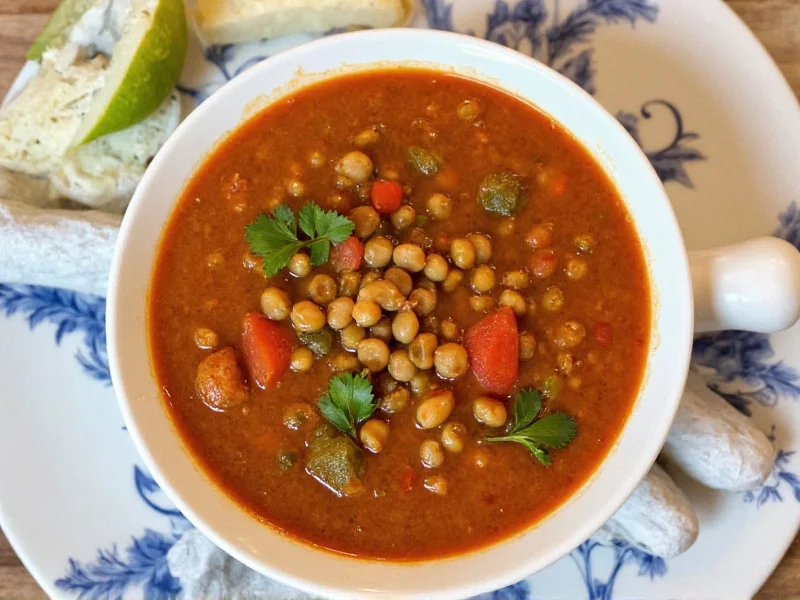For anyone exploring authentic Turkish cuisine, mercimek çorbası represents more than just a meal—it's a cultural institution. This vibrant red soup appears daily in homes, restaurants, and even school cafeterias across Turkey. Unlike Western lentil soups that often include meat broth or bacon, the traditional Turkish version remains completely plant-based, making it accessible to diverse dietary preferences while delivering exceptional flavor.
The Cultural Significance of Mercimek Çorbası
Turkish red lentil soup traces its origins to Anatolia, where lentils have grown for thousands of years. Archaeological evidence shows lentil cultivation in the region dating back to 8000 BCE. The simplicity of mercimek çorbası reflects Turkish culinary philosophy: maximize flavor from minimal, seasonal ingredients. Families often serve this soup as the opening course of a traditional Turkish meal, believing it prepares the stomach for digestion.
In Turkish culture, offering soup to guests symbolizes hospitality and care. Many Turkish households maintain their own family variations of the recipe, passed down through generations. The soup's affordability and nutritional density made it particularly valuable during economic hardships, cementing its place as a national comfort food.
Authentic Ingredients and Their Purpose
What distinguishes authentic Turkish lentil soup from other lentil preparations? The answer lies in both ingredient selection and technique:
| Core Ingredient | Traditional Role | Substitution Warning |
|---|---|---|
| Red lentils (kırmızı mercimek) | Creates smooth texture without blending | Green/brown lentils require longer cooking and won't achieve authentic consistency |
| Turkish red pepper paste (biber salçası) | Adds depth and authentic flavor | Regular tomato paste lacks the distinctive roasted pepper notes |
| Fresh lemon juice | Added at serving for brightness | Vinegar creates an off-flavor compared to traditional preparation |
| Dried mint (nane) | Provides signature aromatic finish | Fresh mint becomes bitter during cooking |
Traditional Turkish Red Lentil Soup Recipe
Follow this authentic method to create mercimek çorbası that would satisfy even the most discerning Turkish home cook. This easy Turkish red lentil soup preparation requires just 30 minutes and common pantry ingredients.
Ingredients for 4 servings
- 1 cup (200g) red lentils, rinsed
- 1 medium onion, finely chopped
- 1 carrot, grated
- 2 tbsp Turkish red pepper paste
- 1 tsp tomato paste
- 1 tsp ground cumin
- 1/2 tsp dried mint
- 6 cups (1.5L) water or vegetable broth
- Salt to taste
- Fresh lemon wedges for serving
- Optional: 1 tbsp butter or olive oil for garnish
Step-by-step preparation
- Saute aromatics: In a medium pot, cook onions and carrots over medium heat until softened (5 minutes)
- Add pastes: Stir in red pepper paste and tomato paste, cooking for 2 minutes to eliminate raw flavor
- Combine ingredients: Add rinsed lentils, cumin, salt, and water/broth. Bring to a gentle boil
- Simmer: Reduce heat and cook uncovered for 20-25 minutes, stirring occasionally, until lentils completely break down
- Final seasoning: Remove from heat, stir in dried mint, and adjust salt
- Serve: Ladle into bowls and add fresh lemon juice and optional butter garnish
The hallmark of perfectly prepared Turkish lentil soup with lemon is its velvety texture without requiring blending. The red lentils should completely disintegrate during cooking, creating a smooth consistency. Many Turks enjoy this soup with a slice of fresh pide bread for dipping—never with crackers, which would be considered inauthentic.
Nutritional Benefits of Traditional Preparation
Turkish lentil soup health benefits make it a nutritional powerhouse. A single serving provides:
- 18g of plant-based protein
- 65% of daily fiber needs
- Significant iron, folate, and potassium
- Only 250 calories per serving
The traditional preparation method preserves maximum nutrients. Unlike Western versions that often include cream or excessive oil, authentic mercimek çorbası relies on the natural creaminess of red lentils. This makes it naturally vegan Turkish lentil soup recipe that satisfies diverse dietary requirements without compromising flavor.
Common Mistakes to Avoid
Even experienced cooks make these errors when attempting authentic Turkish red lentil soup recipe:
- Using the wrong lentils: Only red lentils create the proper texture without blending
- Skipping the paste cooking step: Raw tomato and pepper paste create unpleasant flavors
- Adding lemon too early: Acid prevents lentils from softening properly
- Over-seasoning: Traditional preparation uses minimal spices to highlight lentil flavor
- Serving without lemon: Fresh citrus is essential for authentic flavor balance
For best results, resist the urge to thicken the soup with flour or cornstarch—the lentils should naturally create a creamy consistency when cooked properly. If your soup seems too thin after cooking, simply simmer uncovered for a few additional minutes.
Modern Adaptations and Serving Traditions
While traditional preparation remains popular, contemporary Turkish kitchens sometimes add personal touches like a swirl of yogurt or fresh parsley. However, purists maintain that the only acceptable garnishes are lemon juice and dried mint.
In Turkey, mercimek çorbası often appears as the first course in a multi-dish meal, followed by a main protein and salad. Many Turkish restaurants offer it as an inexpensive, nourishing option that represents the essence of Turkish hospitality. The soup's simplicity belies its cultural importance—it appears in Turkish literature, proverbs, and even political discourse as a symbol of national identity.











 浙公网安备
33010002000092号
浙公网安备
33010002000092号 浙B2-20120091-4
浙B2-20120091-4